
As AV turns 15, let's take a look back at the site we descended from. Below you can explore the database Olivier compiled at Animated Movies during its existence, as it last appeared online in October 2003.
 | Animated Movies was launched by Olivier Mouroux in 1999. In addition to a daily news report, he also created a database of information about past, current, and upcoming films. In 2003, he took a job in the industry and had to give up his work on the site. Several fans of Animated Movies decided to take on the task of keeping the news portion of his site going, and founded what is now Animated Views. As AV turns 15, let's take a look back at the site we descended from. Below you can explore the database Olivier compiled at Animated Movies during its existence, as it last appeared online in October 2003. |

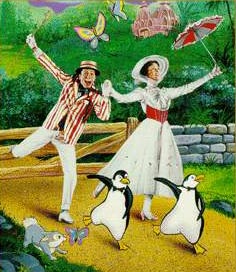 Directed
by: Robert Stevenson
Directed
by: Robert Stevenson
Written by: P.L. Travers (books) &
Bill Walsh
Music by: Richard
M. Sherman & Robert B. Sherman
Released on: August 26, 1964
Running Time: 140 minutes
Budget: $
Box-Office: $102.3 in the U.S., $ million
worldwide ($44M in its first U.S. release and $45 million in rentals)
 Mary
Poppins... Julie Andrews
Mary
Poppins... Julie Andrews
Bert/Mr. Dawes Sr... Dick Van Dyke
George Banks... David Tomlinson
Winifred Banks... Glynis Johns
Jane Banks... Karen Dotrice
Michael Banks... Matthew Garber
Katie Nanna... Elsa Lanchester
Ellen... Hermione Baddeley
Mrs. Brill... Reta Shaw
![]() The opening shot
of Mary Poppins sitting on a cloud contains a gag originally used in Disney's
Dumbo.
While Poppins checks her make-up, her carpetbag slides "through" the cloud.
She catches it repeatedly just before it falls to oblivion. The stork delivering
Dumbo does the same thing with his bundle.
The opening shot
of Mary Poppins sitting on a cloud contains a gag originally used in Disney's
Dumbo.
While Poppins checks her make-up, her carpetbag slides "through" the cloud.
She catches it repeatedly just before it falls to oblivion. The stork delivering
Dumbo does the same thing with his bundle.
![]() The film was shot
entirely indoors.
The film was shot
entirely indoors.
![]() During one particularly
long camera set up, Julie Andrews was left hanging in mid-air. The stagehands
unwittingly lowered her wire harness rather rapidly. "Is she down yet?"
called a grip. "You bloody well better believe she is!" fumed Andrews.
During one particularly
long camera set up, Julie Andrews was left hanging in mid-air. The stagehands
unwittingly lowered her wire harness rather rapidly. "Is she down yet?"
called a grip. "You bloody well better believe she is!" fumed Andrews.
![]()
![]() The
adorable Matthew Garber (7-year old Michael Banks) died tragically of pancreatitis
at the age of 21, in 1977.
The
adorable Matthew Garber (7-year old Michael Banks) died tragically of pancreatitis
at the age of 21, in 1977.
![]() The twins, John
and Barbara Banks, from P.L. Travers' books, do not feature at all in Disney's
version of Mary Poppins.
The twins, John
and Barbara Banks, from P.L. Travers' books, do not feature at all in Disney's
version of Mary Poppins.
![]() The animated "Jolly
Holiday" sequence was directed by Disney veteran Hamilton S. Luske and
boasted the talents of five of Walt Disney's legendary "Nine Old Men" --
Milt Kahl, Ollie Johnston, John Lounsbery, Frank Thomas, Ward Kimball,
and Eric Larson.
The animated "Jolly
Holiday" sequence was directed by Disney veteran Hamilton S. Luske and
boasted the talents of five of Walt Disney's legendary "Nine Old Men" --
Milt Kahl, Ollie Johnston, John Lounsbery, Frank Thomas, Ward Kimball,
and Eric Larson.
![]() Young stars Karen
Dotrice and Matthew Garber delighted in the magical carousel horse ride,
which took a week to film, but Julie Andrews and Dick Van Dyke relied on
motion sickness medication to help them cope with the constant up-and-down
movement of the merry-go-round steeds.
Young stars Karen
Dotrice and Matthew Garber delighted in the magical carousel horse ride,
which took a week to film, but Julie Andrews and Dick Van Dyke relied on
motion sickness medication to help them cope with the constant up-and-down
movement of the merry-go-round steeds.
![]() Storyman Bill
Peet recalled in the late '90s that Walt Disney "always held up Disneyland
and, later, Mary Poppins as being great. It was something tangible
that he could see; the cameras filming, the sets being built and the special
effects. Everything happening right then and there. Animation took too
long. Walt would have to wait forever to see the results, and then you
don't dare watch it because if there's a mistake there's nothing you can
do about it because you've spent the money. You can't just cut out pieces
because it costs so much. Live action, you just shoot again tomorrow and
you can tell the actors what to do. Walt could control live action, too.
He always wanted to compete with the big shots and make a Gone With
the Wind or something. [Mary Poppins] is about a wealthy
British family that no one can identify with, let alone a nanny. I thought
Mary
Poppins was an icky, sweet nothing. [Mrs. Travers, the author],
came to the studio and was tougher than hell. She tried to oversee it and
insisted that she be involved in some advisory role. They wouldn't let
her do it because she would have raised hell every day. She was a witch
of a woman and a real pain in the ass."
Storyman Bill
Peet recalled in the late '90s that Walt Disney "always held up Disneyland
and, later, Mary Poppins as being great. It was something tangible
that he could see; the cameras filming, the sets being built and the special
effects. Everything happening right then and there. Animation took too
long. Walt would have to wait forever to see the results, and then you
don't dare watch it because if there's a mistake there's nothing you can
do about it because you've spent the money. You can't just cut out pieces
because it costs so much. Live action, you just shoot again tomorrow and
you can tell the actors what to do. Walt could control live action, too.
He always wanted to compete with the big shots and make a Gone With
the Wind or something. [Mary Poppins] is about a wealthy
British family that no one can identify with, let alone a nanny. I thought
Mary
Poppins was an icky, sweet nothing. [Mrs. Travers, the author],
came to the studio and was tougher than hell. She tried to oversee it and
insisted that she be involved in some advisory role. They wouldn't let
her do it because she would have raised hell every day. She was a witch
of a woman and a real pain in the ass."
![]() One reason "Mary
Poppins" has been described as Walt Disney's greatest film achievement
is that Walt employed all his resources in its production, including the
newly developed Audio-Animatronics technology. That's right, the robin
that whistles along with Mary Poppins in the "Spoonful of Sugar" number
is an Audio-Animatronic figure.
One reason "Mary
Poppins" has been described as Walt Disney's greatest film achievement
is that Walt employed all his resources in its production, including the
newly developed Audio-Animatronics technology. That's right, the robin
that whistles along with Mary Poppins in the "Spoonful of Sugar" number
is an Audio-Animatronic figure.
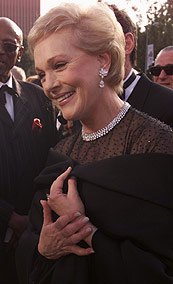
![]() The set for the Banks family's neighborhood on Cherry Tree Lane filled
an entire sound stage at the Disney Studios and featured four full-scale
Georgian-style houses, including the Banks home at No. 17 and Admiral Boom's
ship-shape house. What would spring be on Cherry Tree Lane without cherry
blossoms? Each of the blooms, made from materials imported from France
and Portugal, was hand-mounted to the set's tree branches.
The set for the Banks family's neighborhood on Cherry Tree Lane filled
an entire sound stage at the Disney Studios and featured four full-scale
Georgian-style houses, including the Banks home at No. 17 and Admiral Boom's
ship-shape house. What would spring be on Cherry Tree Lane without cherry
blossoms? Each of the blooms, made from materials imported from France
and Portugal, was hand-mounted to the set's tree branches.
![]() Julie Andrews'
airborne scenes in Mary Poppins were accomplished with the aid of
a wired harness beneath her costume--which snapped during one scene, letting
her crash to the stage below. "I let loose with some very un-Poppins Anglo-Saxon
verbs!"
Julie Andrews'
airborne scenes in Mary Poppins were accomplished with the aid of
a wired harness beneath her costume--which snapped during one scene, letting
her crash to the stage below. "I let loose with some very un-Poppins Anglo-Saxon
verbs!"
![]() The Grammy Award-winning
original soundtrack album of Mary Poppins was the best-selling LP
of 1965, outdistancing even the immensely popular "Beatles 65" album. The
"Mary Poppins" soundtrack LP was awarded two gold records and became one
of the top-selling albums in history.
The Grammy Award-winning
original soundtrack album of Mary Poppins was the best-selling LP
of 1965, outdistancing even the immensely popular "Beatles 65" album. The
"Mary Poppins" soundtrack LP was awarded two gold records and became one
of the top-selling albums in history.
![]() Robert Sherman (born on December 19, 1925) and Richard Sherman have created
some of the most memorable Disney music: they wrote music for The
Jungle Book (1967), Bedknobs
and Broomsticks (1971), The
Many Adventures of Winnie the Pooh (1977) and The
Tigger Movie (2000), just to name a few. Richard Sherman reported
during Walt Disney's 100th birthday ceremony, on December 5, 2001, that
one decision that Walt made, to replace live human waiters with animated
penguins, was an example of how the producer made everything extraordinary.
Sherman said that, over the years, he and his brother would visit Walt's
office each Friday to talk about what they were currently working on. Walt
would ask them to play "Feed the Birds" from Mary Poppins, and then send
them on their way for the weekend. After Walt passed away, Sherman said
while fighting off tears, he would still visit Walt's office on Fridays
to play the all-time favorite song for him.
Robert Sherman (born on December 19, 1925) and Richard Sherman have created
some of the most memorable Disney music: they wrote music for The
Jungle Book (1967), Bedknobs
and Broomsticks (1971), The
Many Adventures of Winnie the Pooh (1977) and The
Tigger Movie (2000), just to name a few. Richard Sherman reported
during Walt Disney's 100th birthday ceremony, on December 5, 2001, that
one decision that Walt made, to replace live human waiters with animated
penguins, was an example of how the producer made everything extraordinary.
Sherman said that, over the years, he and his brother would visit Walt's
office each Friday to talk about what they were currently working on. Walt
would ask them to play "Feed the Birds" from Mary Poppins, and then send
them on their way for the weekend. After Walt passed away, Sherman said
while fighting off tears, he would still visit Walt's office on Fridays
to play the all-time favorite song for him.
![]() According to Robert
Sherman, P.L. Travers was demanding near-complete creative control on the
film. She and Walt had many fights over her frequent nitpicking during
production. Among other things, she tried to insist that the costumers
purchase the material for Mary's skirt from a specific dress shop in the
Kensington Road in London. Given the amount of trouble she caused, Walt
bought Bedknobs and Broomsticks
in case she pulled the rights.
According to Robert
Sherman, P.L. Travers was demanding near-complete creative control on the
film. She and Walt had many fights over her frequent nitpicking during
production. Among other things, she tried to insist that the costumers
purchase the material for Mary's skirt from a specific dress shop in the
Kensington Road in London. Given the amount of trouble she caused, Walt
bought Bedknobs and Broomsticks
in case she pulled the rights.
![]() British-born special-effects
artist Peter Ellenshaw provided the inspiration for the spectacular chimney-sweep
dance. When co-producer Bill Walsh mentioned his search for a suitable
theme to inspire the rooftop number, Peter recalled "Knees Up, Mother Brown,"
an old English knockabout. Peter showed Bill and the songwriters, Richard
and Robert Sherman, how to link elbows and dance across the room as the
rowdy song was sung. They eventually demonstrated it for Walt Disney, who
liked the dance so much he joined in himself. The concept was approved
and the Sherman brothers composed their own version of the song, "Step
in Time."
British-born special-effects
artist Peter Ellenshaw provided the inspiration for the spectacular chimney-sweep
dance. When co-producer Bill Walsh mentioned his search for a suitable
theme to inspire the rooftop number, Peter recalled "Knees Up, Mother Brown,"
an old English knockabout. Peter showed Bill and the songwriters, Richard
and Robert Sherman, how to link elbows and dance across the room as the
rowdy song was sung. They eventually demonstrated it for Walt Disney, who
liked the dance so much he joined in himself. The concept was approved
and the Sherman brothers composed their own version of the song, "Step
in Time."
![]() In the end credit
cast list, the actor playing Mr. Dawes Sr. is initially shown as NACKVID
KEYD, then the letters unscramble themselves to show that this is a second
role played by Dick Van Dyke.
In the end credit
cast list, the actor playing Mr. Dawes Sr. is initially shown as NACKVID
KEYD, then the letters unscramble themselves to show that this is a second
role played by Dick Van Dyke.
![]()
 Mary
Poppins was nominated for 13 Academy Awards in 1965, and won for Best
Actress (Julie Andrews), Best Song (Chim-Chim-Cher-ee), Best Music Score,
Best Film Editing, and Best Special Visual Effects. It is interesting
to note that 7 of the 8 other nominations were lost to George Cukor's My
Fair Lady, a movie that Julie Andrews originally wanted to make instead
of Mary Poppins!
Mary
Poppins was nominated for 13 Academy Awards in 1965, and won for Best
Actress (Julie Andrews), Best Song (Chim-Chim-Cher-ee), Best Music Score,
Best Film Editing, and Best Special Visual Effects. It is interesting
to note that 7 of the 8 other nominations were lost to George Cukor's My
Fair Lady, a movie that Julie Andrews originally wanted to make instead
of Mary Poppins!
![]() When developing
its made-for-TV project Gepetto in the late '90s, with music by
Stephen Schwartz, Disney originally wanted
to cast Dick Van Dyke as Geppetto and Julie Andrews as the Blue Fairy.
Sadly, the stars of Mary Poppins could not be reunited some 35 years
after the fact, since the Mouse offered this role to Andrews just months
after she had had that surgery that had so badly damaged her vocal cords.
So Julie reluctantly had to take a pass on the project. Dick Van Dyke,
however, was supposedly very interested in playing the part of Geppetto,
but the deal (for some reason or another) fell through.
When developing
its made-for-TV project Gepetto in the late '90s, with music by
Stephen Schwartz, Disney originally wanted
to cast Dick Van Dyke as Geppetto and Julie Andrews as the Blue Fairy.
Sadly, the stars of Mary Poppins could not be reunited some 35 years
after the fact, since the Mouse offered this role to Andrews just months
after she had had that surgery that had so badly damaged her vocal cords.
So Julie reluctantly had to take a pass on the project. Dick Van Dyke,
however, was supposedly very interested in playing the part of Geppetto,
but the deal (for some reason or another) fell through.
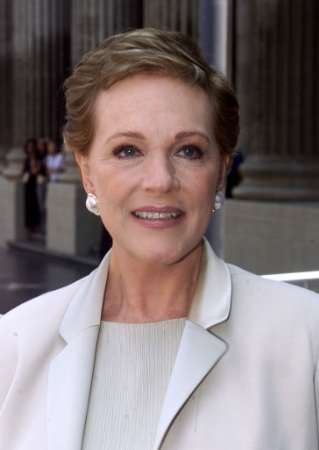
![]() The Princess Diaries (2001), Julie Andrews' first Disney movie since
Mary
Poppins, was shot, in part, on the same soundstage upon which
Poppins
was filmed nearly forty years ago. "Of course the studio is so different
now. Back then it was a little smaller and more charming. Back then you
also walked everywhere, now it's so huge." Born Julie Wells in 1935, Andrews
recalls "kind of being born into" being a singer. "My mother and stepfather
were in vaudeville, and to keep me occupied during the war years, as I
was out of school, I took singing lessons." She and her parents thus "discovered,
to everyone's amazement, that I had this freak voice, a child protege."
So suddenly, Andrews explains, "I was launched, at age 12, into this career,
because I could sing the hell out of an Aria. And had a four octave range.''
The Princess Diaries (2001), Julie Andrews' first Disney movie since
Mary
Poppins, was shot, in part, on the same soundstage upon which
Poppins
was filmed nearly forty years ago. "Of course the studio is so different
now. Back then it was a little smaller and more charming. Back then you
also walked everywhere, now it's so huge." Born Julie Wells in 1935, Andrews
recalls "kind of being born into" being a singer. "My mother and stepfather
were in vaudeville, and to keep me occupied during the war years, as I
was out of school, I took singing lessons." She and her parents thus "discovered,
to everyone's amazement, that I had this freak voice, a child protege."
So suddenly, Andrews explains, "I was launched, at age 12, into this career,
because I could sing the hell out of an Aria. And had a four octave range.''
![]() It was confirmed officially
in May 2002 that discussions for a stage version of Mary
Poppins were underway. The project will be a joint venture between
Disney Theatricals (who holds the rights to the songs from the 1964 film)
and producer Cameron Mackintosh (Cats, Les Misérables,
who has the rights to the original P.L. Travers story). Both were officially
mulling options for a creative team as of October 2002, with an eye toward
the 2004-05 season at the earliest. No firmer details are available, except
that Mary Poppins will land in London before packing her umbrella for Broadway.
It was confirmed officially
in May 2002 that discussions for a stage version of Mary
Poppins were underway. The project will be a joint venture between
Disney Theatricals (who holds the rights to the songs from the 1964 film)
and producer Cameron Mackintosh (Cats, Les Misérables,
who has the rights to the original P.L. Travers story). Both were officially
mulling options for a creative team as of October 2002, with an eye toward
the 2004-05 season at the earliest. No firmer details are available, except
that Mary Poppins will land in London before packing her umbrella for Broadway.
![]() Jim
Hill comments that "way back in 1994, when then-Chairman of Disney
Theme Parks and Resorts Dick Nunis was being interviewed at the Beauty
& the Beast cast party, he was asked 'What's Disney going to
do next on Broadway?' Nunis' response: 'I'm really not at liberty to say
right now. But I can tell you that--if all goes according to plan--it will
make for one Supercalifraglisticexpialidocious evening at the theater.'
You see, Olivier? Disney's been trying to get the stage version of Poppins
off the ground for over eight years now. The smart money right now is on
Disney trying to get the show up and running on Broadway by Fall of 2004
(So that they can capitalize on the film's 40th anniversary)."
Jim
Hill comments that "way back in 1994, when then-Chairman of Disney
Theme Parks and Resorts Dick Nunis was being interviewed at the Beauty
& the Beast cast party, he was asked 'What's Disney going to
do next on Broadway?' Nunis' response: 'I'm really not at liberty to say
right now. But I can tell you that--if all goes according to plan--it will
make for one Supercalifraglisticexpialidocious evening at the theater.'
You see, Olivier? Disney's been trying to get the stage version of Poppins
off the ground for over eight years now. The smart money right now is on
Disney trying to get the show up and running on Broadway by Fall of 2004
(So that they can capitalize on the film's 40th anniversary)."
![]() However, following the
announcement that Thomas Schumacher might leave Disney in June 2003, sources
close to the project deem it "highly unlikely" and "almost inconceivable"
that British producer Cameron Mackintosh would proceed on Mary Poppins
as a stage musical without Mr. Schumacher at the Disney helm. Variety reports
that the two men have been in talks for several months regarding a stage
version of the P.L. Travers classic, and adds on a related note that the
Mary
Poppins film boasts 14 original songs, not requiring any new number
to be written for a full-size stage production.
However, following the
announcement that Thomas Schumacher might leave Disney in June 2003, sources
close to the project deem it "highly unlikely" and "almost inconceivable"
that British producer Cameron Mackintosh would proceed on Mary Poppins
as a stage musical without Mr. Schumacher at the Disney helm. Variety reports
that the two men have been in talks for several months regarding a stage
version of the P.L. Travers classic, and adds on a related note that the
Mary
Poppins film boasts 14 original songs, not requiring any new number
to be written for a full-size stage production.
![]() Broadway.com announced
officially in March 2003 that renowned director Richard Eyre (Guys and
Dolls) would helm the highly anticipated Mary Poppins stage musical,
Oscar-winning screenwriter Julian Fellowes (Gosford Park) would
write the book and songwriting team George Stiles and Anthony Drewe would
supplement the film's score with new material.
Broadway.com announced
officially in March 2003 that renowned director Richard Eyre (Guys and
Dolls) would helm the highly anticipated Mary Poppins stage musical,
Oscar-winning screenwriter Julian Fellowes (Gosford Park) would
write the book and songwriting team George Stiles and Anthony Drewe would
supplement the film's score with new material.
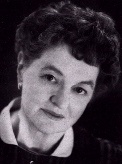 The
story of Mary Poppins was written by P.L. Travers and was published in
1934. It was already a very popular book in England. Walt Disney's interest
in the story dated back to 1939, and in 1944 his brother, Roy Disney, began
negotiations with P.L. Travers whilst she was living in New York to escape
the Nazi bombings of London. It was to be a long wait for Disney.
Mary Poppins was originally conceived as an animated feature, but the author
(Australian P.L. Travers) refused to sell the rights to her books in these
conditions, stating that she "could not conceive of Mary Poppins as a cartoon
character." The tenacious author finally released the film rights to them
in 1961, more than fifteen years after discussions first began.
The
story of Mary Poppins was written by P.L. Travers and was published in
1934. It was already a very popular book in England. Walt Disney's interest
in the story dated back to 1939, and in 1944 his brother, Roy Disney, began
negotiations with P.L. Travers whilst she was living in New York to escape
the Nazi bombings of London. It was to be a long wait for Disney.
Mary Poppins was originally conceived as an animated feature, but the author
(Australian P.L. Travers) refused to sell the rights to her books in these
conditions, stating that she "could not conceive of Mary Poppins as a cartoon
character." The tenacious author finally released the film rights to them
in 1961, more than fifteen years after discussions first began.
 P.L.
Travers had portrayed Mary Poppins as a middle-aged woman, and Walt Disney
first considered Bette Davis for the role. But as the score by the Sherman
brothers was developed, it appeared that the role would require singing.
Mary Martin was a candidate, but she decided against a return to films.
Walt began thinking that Mary Poppins could be played by a younger actress,
and he was receptive when his secretary, Tommie Wilck, suggested Julie
Andrews, who had starred in the musical "My Fair Lady" and was then appearing
in Broadway in "Camelot".
P.L.
Travers had portrayed Mary Poppins as a middle-aged woman, and Walt Disney
first considered Bette Davis for the role. But as the score by the Sherman
brothers was developed, it appeared that the role would require singing.
Mary Martin was a candidate, but she decided against a return to films.
Walt began thinking that Mary Poppins could be played by a younger actress,
and he was receptive when his secretary, Tommie Wilck, suggested Julie
Andrews, who had starred in the musical "My Fair Lady" and was then appearing
in Broadway in "Camelot".
 Mrs.
Travers approved heartily of the casting of Julie Andrews after hearing
her only on the telephone. Andrews granted the interview from her bed after
the delivery of her daughter, Emma Walton. Julie Andrews' agreement
with the studio stipulated that she would be released from the film if
Warner Brothers should cast her as Eliza Doolittle in the movie version
of My Fair Lady. Jack L. Warner, who was producing the film, chose
Audrey Hepburn instead. It is interesting to note that while
My
Fair Lady won the Oscar for Best Film that year, Audrey Hepburn was
not even nominated in the Best Actress category.
Mrs.
Travers approved heartily of the casting of Julie Andrews after hearing
her only on the telephone. Andrews granted the interview from her bed after
the delivery of her daughter, Emma Walton. Julie Andrews' agreement
with the studio stipulated that she would be released from the film if
Warner Brothers should cast her as Eliza Doolittle in the movie version
of My Fair Lady. Jack L. Warner, who was producing the film, chose
Audrey Hepburn instead. It is interesting to note that while
My
Fair Lady won the Oscar for Best Film that year, Audrey Hepburn was
not even nominated in the Best Actress category.
 In
the early stages of production, Dick Van Dike (who Disney had never heard
of until then) was being tested in various makeups for later sequences.
To relieve the boredom, he delivered snatches of comedy routines. One of
them was his impression of an aged man desperately striving to step down
from a sideway curb without an injury. When Walt viewed the test in a projection
room, he decided immediately to cast Van Dyke as the antediluvian Mr. Dawes,
board chairman of the bank. He instructed that a 6-inch miser be built
on the board-room set, so that Dick could do the stepping-down routine.
In
the early stages of production, Dick Van Dike (who Disney had never heard
of until then) was being tested in various makeups for later sequences.
To relieve the boredom, he delivered snatches of comedy routines. One of
them was his impression of an aged man desperately striving to step down
from a sideway curb without an injury. When Walt viewed the test in a projection
room, he decided immediately to cast Van Dyke as the antediluvian Mr. Dawes,
board chairman of the bank. He instructed that a 6-inch miser be built
on the board-room set, so that Dick could do the stepping-down routine.
Walt Disney instructed director Robert Stevenson not to concern himself about the animation; that would be filled in later. "Don't worry, whatever the action is, my animators will top it."
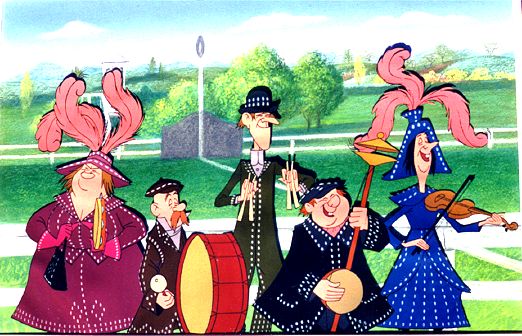 Travers
was a pill about details in the script, driving many of the Disney writers
to distraction about Poppins minutiae. After seeing the final film, she
devised a list of changes she wanted. Her requests went unheeded after
Walt himself pointed out that although she had SCRIPT approval, she didn't
have FINAL DRAFT approval. Among the things that Travers disliked was the
Sherman Brothers score. She wanted the only music in the movie to be period
pieces such as "Ta Ra Ra Boom De Ay."
Travers
was a pill about details in the script, driving many of the Disney writers
to distraction about Poppins minutiae. After seeing the final film, she
devised a list of changes she wanted. Her requests went unheeded after
Walt himself pointed out that although she had SCRIPT approval, she didn't
have FINAL DRAFT approval. Among the things that Travers disliked was the
Sherman Brothers score. She wanted the only music in the movie to be period
pieces such as "Ta Ra Ra Boom De Ay."